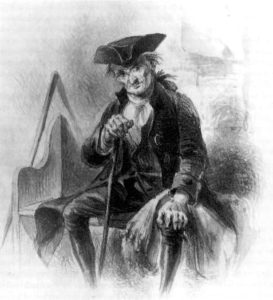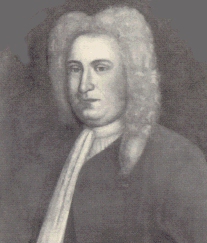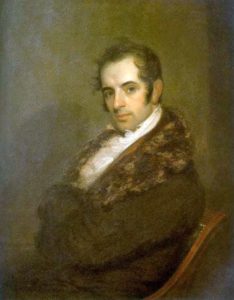by Judith Flanders
Instead of deriving from folklore, or quaint colonial customs, or religion, the American emergence of Santa Claus was rooted in late-eighteenth-century politics, in the formation of clubs and societies based around ethnic or cultural groups, which came together to promote themselves and their fellow immigrants: a St Andrew’s Society for Scots immigrants, St David’s for the Welsh, St Patrick and St George for the Irish and the English. In 1786 a mostly Irish group called itself the Sons of St Tammany. (Tamanend had been a Lenni-Lenape chief when European colonists first established Philadelphia, so the choice of name was a jab at the British.)
 One of the founders of the Sons of St Tammany was a merchant named Lewis Pintard (although he was of Huguenot, rather than Irish, descent), the guardian of his orphaned nephew, John Pintard. Pintard Jr also became a merchant, but he was more interested in charitable endeavours and in history than in trade, and in 1804 helped found the New-York Historical Society, which took St Nicholas as its emblem, possibly as a nod to Pintard’s Huguenot heritage: many American Huguenots originated in the Low Countries, especially Wallonia, where the cult of Nicholas was particularly prominent. Pintard himself had previously marked the saint’s day, 6 December, as a private day of thanksgiving for the world’s first three republics: those of France, the United Provinces and the United States.
One of the founders of the Sons of St Tammany was a merchant named Lewis Pintard (although he was of Huguenot, rather than Irish, descent), the guardian of his orphaned nephew, John Pintard. Pintard Jr also became a merchant, but he was more interested in charitable endeavours and in history than in trade, and in 1804 helped found the New-York Historical Society, which took St Nicholas as its emblem, possibly as a nod to Pintard’s Huguenot heritage: many American Huguenots originated in the Low Countries, especially Wallonia, where the cult of Nicholas was particularly prominent. Pintard himself had previously marked the saint’s day, 6 December, as a private day of thanksgiving for the world’s first three republics: those of France, the United Provinces and the United States.

In this same period, a young writer named Washington Irving was drawing on New York’s Dutch history for political satire, contrasting what he thought of as a kinder and gentler Old World in New Amsterdam with the hustle and bustle of modern New York. In his 1809 burlesque, A History of New-York, published under the mock-Dutch pseudonym of Diedrich Knickerbocker (and thus often later known as the Knickerbocker History), to be a New Amsterdammer rather than a New Englander was to be a real New Yorker. The New-York Historical Society members also used New Amsterdam as a contrast to what they viewed as the ills of the present in their rapidly changing city. In 1809, the toast at the society’s annual dinner ran: ‘To the memory of St Nicholas. May the virtuous habits and simple manners of our Dutch ancestors be not lost in the luxuries and refinements of the present time.’

Irving’s History of New-York was hugely successful, making his name, but also clouding its comic origins. Instead, the book began to be read as though it described real events. The History claimed that the first church in New Amsterdam was dedicated to St Nicholas, in honour of the colonists’ patron saint, and, sure enough, half a century later, this was repeated as fact in a history of New York. (In actuality, there was no New York church named for St Nicholas until the twentieth century.) Had anyone paused to check, the History could not have passed as history for a moment: Irving described ‘Dutch’ New York cookies being impressed with, on one side, an image of Rip van Dam, the lieutenant-governor of New Amsterdam, on the other ‘the noted St. Nicholas, vulgarly called Sancteclaus . . . venerated by true Hollanders.’ The historical Rip van Dam was indeed a New York politician, but one who had governed years after Dutch New Amsterdam had turned into British New York.
Yet the Nicholas legend-building continued. In 1810, for the next St Nicholas dinner, Pintard produced a broadside bearing an engraving of ‘the good holy man’ St Nicholas in his bishop’s robes, holding his bags of gold, and, next to it, pictures of good and bad children by a fireplace hung with stockings.* Underneath was a verse, in Dutch and in English:
St Nicholas, my dear good friend!
To serve you ever was my end,
If you will, now, me something give,
I’ll serve you ever while I live.
Pintard claimed this verse had been recited to him by ‘an ancient lady 87 years of age’. It is possible, of course, that Pintard did hear it from an elderly Dutch lady, although if she had been eighty-seven in 1810, not only had she been born in an English colony, but so had her parents. It seems likely, therefore, that Pintard invented the verses, and possibly even the old lady, for the verses included one detail that had not previously been known in the Netherlands: that the saint lived in Spain the rest of the year. By later in the nineteenth century, this tradition was a regular feature of Dutch descriptions of ‘their’ St Nicholas, but there is no evidence of it appearing in the Low Countries before Pintard’s broadside.
Legend, however, easily trumped fact. Two weeks after that dinner, the New York Spectator published a poem about the ‘good holy man’ – the Dutch phrase repeated by Pintard – adding: ‘whom we Sancte Claus name’. The poem, too, concentrated on the Dutch roots of the city, its saint bringing not apples, as he did in German lands, but a ‘bright Orange’, tipping its hat to the Dutch princes of Orange-Nassau. (It is noticeable too that these Englishspeaking authors all used versions the German word Sankt, not the Dutch Sint.) Two years later, knowledge of Sancte Claus had spread widely enough for a censorious volume for children, False Stories Corrected, to dismiss ‘Old Santaclaw, of whom so often little children hear such foolish stories; and once in the year are encouraged to hang their stockings in the Chimney at night’. By 1830 he was firmly enough established that a New York bookseller advertised that in his ‘Temple’ of ‘Santaclaus’ customers could return to ‘the good ways of their fathers’: less than twenty-one years after his American birth, he was already a piece of nostalgia.

So it appears Washington Irving, John Pintard and their friends should be credited with the creation of Santa Claus. Or should they? Almost everything suggests that they were the creators – were it not for two references in a New York newspaper to ‘Santa Claus’ in 1773 and 1774, the first appearing when John Pintard was fourteen, and Irving not yet born. Once more we need to stop and rewind.
On 23 December 1773 Rivington’s New-York Gazetteer reported: ‘Last Monday the anniversary of St. Nicholas, otherwise called Santa Claus, was celebrated at Protestant Hall . . . where a great number of sons of that ancient saint celebrated the day with great joy and festivity.’ There was a similar mention in 1774, followed by decades of silence.
‘Last’ Monday might have been the 20th, or possibly the 13th, of December. What it wasn’t was 6 December, just as, later, the New-York Historical Society took an elastic approach to the saint’s day, their annual dinner by no means always falling on 6 December. The meeting at the Protestant Hall, ‘at Mr. Samuel Waldron’s, on Long Island’, makes it sound as if Mr Waldron might have been running a pub with a meeting-room attached. (He also hosted St Patrick’s Day events, so the ‘Protestant’ part seems nominal.) It is unlikely that this was an anti-British group, as Rivington’s Gazetteer was published by John Rivington, a loyalist so famously stalwart he was hanged in effigy by the Sons of Liberty in 1775. Where, then, did this St Nicholas group, who used the name ‘Santa Claus’, come from? No explanation, nor even any guess, has ever been put forward. It might be, however, that it was another immigrant group, neither Dutch, nor pseudo-Dutch, which supplies the missing link between St Nicholas and Santa.
* The phrase ‘De Goedheiligman’ is used today in the Netherlands to refer to the saint; I have been unable to determine if it was in use before Pintard, or whether this was a New World borrowing.
JUDITH FLANDERS is a New York Times bestselling author and one of the foremost social historians of the Victorian era. She is a frequent contributor to The Wall Street Journal, The Daily Telegraph, and The Times Literary Supplement. She lives in London. Her books include The Victorian City.
